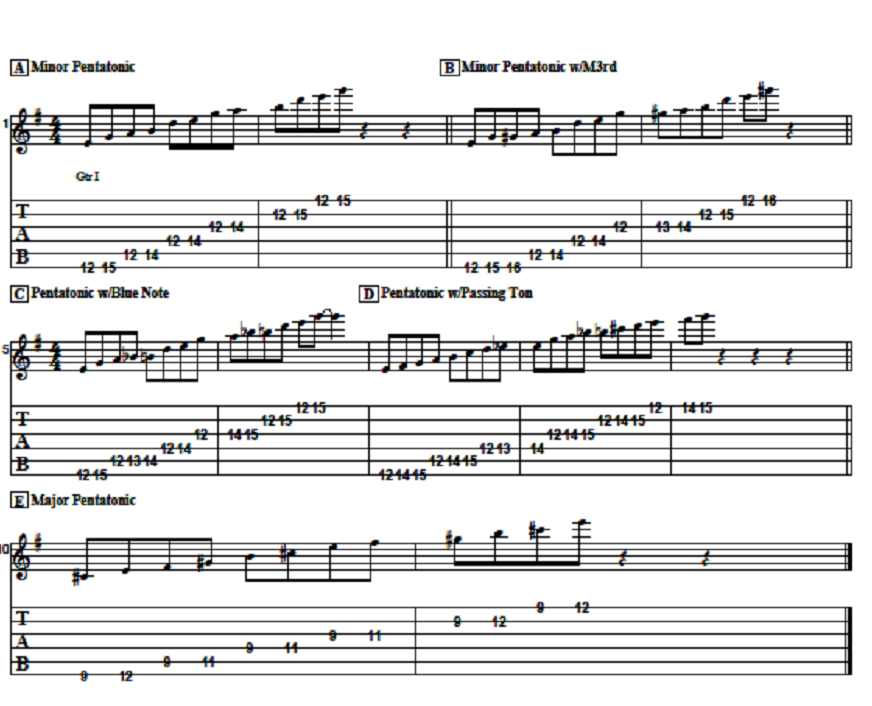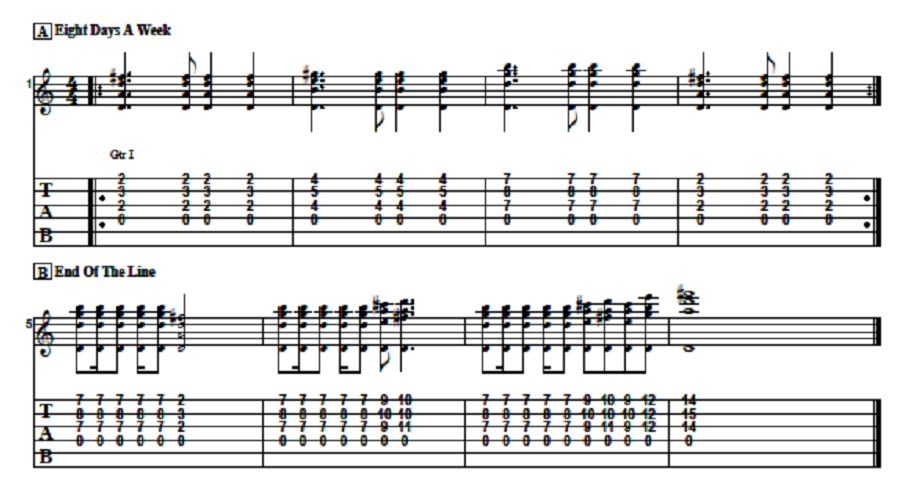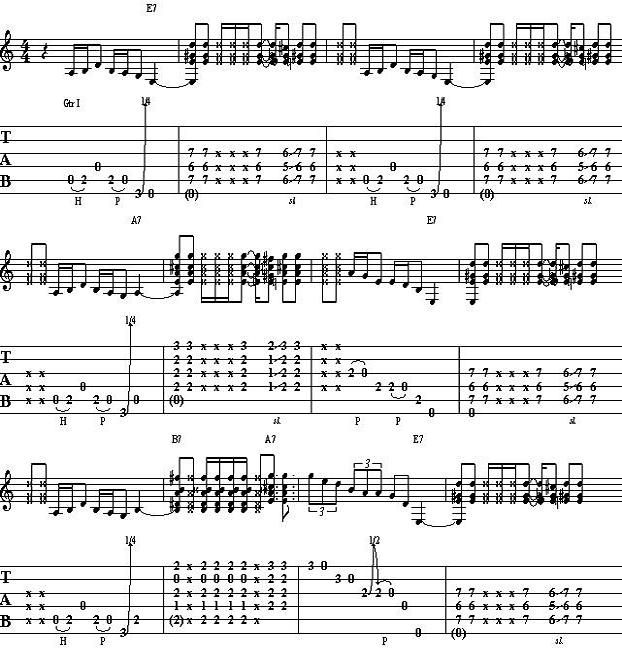Guitar Control presents instructor Darrin Goodman with another, always free, lesson. Today Darrin teaches the Pentatonic scale and some killer variations you can do to spice it up. Be sure to click the link for the free tabs so you can easily follow along.
[contentwall]

[/contentwall][ninja-popup ID=715]
Overview
Hey everybody how’s it going? This is Darrin with GuitarControl.com bringing you this video lesson. Today I’m going to show you how to play the first position of the minor pentatonic scale and we’re going to do some variations some simple variations you can do with the scale to just to kind of give you more variety of stuff to play and lick ideas and stuff like that. So be sure to click on the link down below so you can get the tabs and you’ll be able to follow along and let’s get close up and take a look what we got going on.
The Pentatonic Scale
All right so first let’s just go over the pentatonic scale pattern, we’re going to be doing this all of these in the key of E minor. The thing that’s nice about this is that once you have this shape down it doesn’t matter where you play it. So we’re starting on the 12th fret of our low E and our first finger is playing that note and it is our first finger is going to play the 12th fret on all six strings so 12 and then it goes to 15 and I’m using my fourth finger and depending upon what I’m playing, sometimes when I’m up this high on the fretboard I will actually use my third finger instead, but just for the sake of this scale because the general rule this is what you’re going to do, so 12 15 and then we go to the fifth string, your A string and it’s 12 14, D string 12 14, G string 12 14, B string 12 15 and high E 12 15.
So I recommend that you that you practice that and get it down where you can play it ascending and descending so that way you know you really have it down. Now like I said it’s a movable shape, so you know if we moved it over here to the ninth fret it would still be the same thing, so just wherever you start is what key you’re in and all of the notes on every string are on the same fret for the first finger.
Adding The Major Third
Okay, so I want to show you some different variations of things that you can do with this. So one of the things is that the pentatonic scale has five notes in it and a diatonic scale has seven notes in it. So what it is we’re missing a couple of notes. If you compare this to the major scale, we’re missing the second note and we are missing the sixth note and the third and the seventh are both flattened. So here we have our root note, our flat third, our fourth, our fifth, our flat seven and then our eight, which is the same as one.
So one of the cool things that I like to do with this scale is to add in the major third with it, so technically if we were going to add that major third in on every place that we could, still we’re playing all the notes on the 12th fret with your first finger. So now we’re gonna go 12 15 and then 16 12 14 12 14 12 13 14 12 15 12 15 16. So you can add those in anywhere you want, but a place that I like to do it that I use quite a bit is just right here, just moving up the note on the 12th fret up a half step. So I just really like the way that that sounds.
The Blue Note
So another variation that we can do on this is to add in what is called the blue note. So the blue note is actually just the flat five. So if we take this and again we’re comparing it to the major scale, so the fifth is the note that’s on the 14th fret of the A string, that’s the first one anyway, so what we’re going to do is we’re going to add in the flat note so we’re going to be back again on the low E 12 15 and then to the A string 12 13 14 to the D string 12 14 to the G string 12 14 15 to the B string 1215 and to the high E 12 15. So it’s just got that really cool sound that just really sounds like the blues.
Adding Passing Tones
Okay, another thing that you can do, and this is something that I do quite a bit, is just to add in some passing tones. So what I like to do is to just add in one extra note per string. So this isn’t like a genuine three note per string pentatonic scale because some of these notes are not part of the scale at all, you’ll see as I show you. So starting at the bottom, we’re at 12, I’m gonna go 12 14 15 and then on to the A string 12 13 14, the D string 12 13 14 and then on the G string 12 14 15, got that blue note there, and then on the B string.
There’s two ways that I do this, sometimes I go 12 13 15 or sometimes I’ll go 12 14 15 just depending upon what it is that I’m playing and then on the high E 12 14 15. Now none of these notes are ones that you’re necessarily going to want to sit on, they don’t really resolve, but it’s just an easy way to kind of add some extra stuff to the scale and I think it sounds pretty cool. Now what I’m saying about the half step on the B string is because if you look at the Mixolydian scale starting on D, which would be in this key, that’s where those notes intersect and I like to use that as well.
Pentatonic Major
All right, so the last thing I want to do is show you how to play the pentatonic major. So the pentatonic major, I’ve seen a lot of different ways people explain how to do this and lot of it is incredibly complicated, but this is a really simple way to do it. So you take whatever key you’re in, so in this key case we were in E minor, so were starting at the 12th fret, so all you do is take that scale shape and move it down a step and a half. So I’m going to move down one step half step so that means that puts my first finger on the ninth fret and then if you just want to play the scale and just omit that first finger, so it’s going to go 12 on the low E and then 9 11 on the A string, 9 11 on the D string, 9 11 on the G string, 9 12 on the B string and 9 12 on the high E. So playing in the pentatonic major scale over a chord progression that you know, like a blues just gives a different sound, it puts more of a like a happy kind of a sound on it, like you hear that done like in southern rock and some country music or even in blues and stuff too; it’s just like a really cool thing. The reason I’m saying about omitting that first note is it’s not that that note isn’t in key, it is, but if you’re just playing the scale you’d want to start on the tonic which is E, but if you were just like improvising something you could you certainly start on that first note on the ninth fret.
All right, so hope you enjoyed that you got something out of it. If you enjoyed this lesson be sure to give it a thumbs up. Leave me a comment down below if there’s something you’d like to see myself or one of the other instructors at GuitarControl.com do in a future lesson. That is all I’ve got for you today so thanks for watching and have a great day.
For more great pentatonic soloing info check out our course “Super Charged Soloing Made Simple” here https://www.guitarcontrol.net/supercharged/




